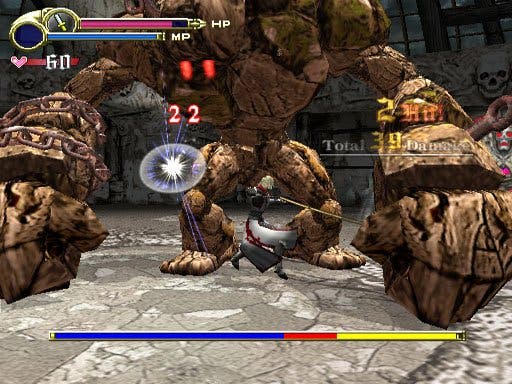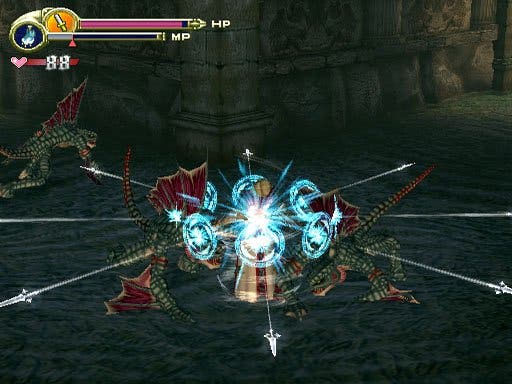Castlevania: Lament of Innocence
The man from Belmont, he say...
Updating a classic 2D franchise into 3D is something of a minefield for even the most experienced and talented development studio. Unless they cheat like hell and create some kind of 2.5D game, designers find themselves faced with the tricky task of working out what exactly defined the success and lasting appeal of the 2D original, and distilling those elements into a new 3D framework. Sometimes they get it spectacularly right, like in Mario 64 or Metroid Prime. Sometimes, well, it doesn't work so well - the disappointing 3D update of Defender being an example that springs readily to mind.
Ahh, fresh victims...

The Castlevania series ranks, in many people's minds, as one of the true pinnacles of 2D platform gaming, combining as it did basic role-playing elements with hardcore platform action and an exploration mechanic similar to that found in Metroid. The series arguably peaked with Castlevania: Symphony of the Night on the PlayStation, which despite being a 2D game regularly shows up in all-time best game lists for the console thanks to the lush artwork, great music, RPG dynamics and superb gameplay.
A foray into 3D for the series on the Nintendo 64 was something of a noble failure, however, and ever since then Castlevania has remained firmly in two dimensions, with a series of excellent Game Boy Advance titles continuing the legacy of the Belmont clan of vampire-hunters. Until now, that is, and with the return of the franchise to home consoles for the first time since the N64, the first outing on a Sony console since Symphony of the Night sees 3D gameplay being given another crack of the whip - literally.
As you might expect from a Castlevania game, Lament of Innocence features the most basic plot imaginable; you play Leon Belmont, a holy knight who leaves his squadron to rescue his beloved, who has been captured by an evil vampire lord. Upon arrival at the forest surrounding the castle, you are met by an old man who lives outside the walls and runs a shop for adventurers seeking to slay the vampire, who - after much hilarious over-acting as both characters ham it up for all their worth - gives you an enchanted whip to use as a weapon and a few words of advice on how to defeat the vampire.
Lashing gorgeous

The first think you'll be struck by, even as you run up towards the castle, as that the game looks absolutely fantastic. Every environment is imaginative and incredibly detailed, with every separate section of the castle (there are six major sections in all, each of which you must explore) having a unique theme. Although the rooms and halls within the different sections do repeat themselves a lot, this rarely becomes annoying, and the rich gothic style of the game is quite unlike anything else we've seen on the PS2. Besides, it occasionally throws out some quite stunning things, with some of the bosses in particular being incredibly imaginative and impressive, and best of all, it throws around these spectacular environments and tons of enemies and weapon effects at a constant 60Hz, with no sign of a frame dropped anywhere along the way. It's also completely full-screen - no nasty PAL borders in sight.
In gameplay terms, this is pure Castlevania - you have a range of combo attacks with your whip as well as a selection of sub-weapons, which can be picked up by breaking special stone torches scattered throughout the castle. Combat is generally a matter of pure timing, as you attempt to measure your combo attacks, avoid getting swarmed by the enemy, block enemy special attacks to replenish your MP, and select the right combination of sub-weapon and magical orbs for a given tricky situation. There are five main magical orbs which you get after you defeat the five key bosses in the game (one at the end of each major section of castle, and then the vampire Walter Bernhard himself after a further castle segment), and each sub-weapon does different things when different magical orbs are equipped.
In many respects, this is old school videogaming without many frills. You enter a room full of enemies, kill them all with some pretty basic (but extremely slick) combat, and proceed to the next room full of enemies. Walk back through the door, and the enemies in the original room will have respawned - although this time, you'll be able to run straight past them if you like, as once you've cleared out a room the doors are unlocked the next time you run through and you don't have to kill all the bad guys again. The last game we saw which used this kind of mechanic so shamelessly was Sega's hugely disappointing Shinobi remake, in fact - although Lament of Innocence is certainly a better and more enjoyable game than Shinobi was, by quite a huge margin. It helps that the combat system does evolve as you go forward, with new combos being learned all the time, and even occasionally new attacks - such as the diving kick attack which turned up late in the game and added quite a new dimension to the combat just at the point where it was starting to feel a little stale.
Whip Crack Along

As you'd rather expect from a game with platformer roots, there are certain platforming elements here as well - Leon can jump, double jump, and grab onto things with his whip and swing from them. However, although there's a comprehensive tutorial at the beginning of the game showing you how to accomplish these various feats of acrobatics, Konami seem to have decided at some point in development that platforming isn't really what this game is about, and have confined it to a number of rooms in each sector which contain (often optional) platform puzzles. This is both a good and a bad thing at once - it's good that Konami recognised the weakness of the platform element of the game and didn't force frustrating and badly conceived platform puzzles on the player, but it's also a real shame that the developers didn't shore up this element of the game and put more platformer sections in to break up the combat-focused gameplay.
In fact, that aspect of the game is symptomatic of the single largest problem with Lament of Innocence as a whole. While the game achieves the things which it sets out to do with polished aplomb - excellent combat, beautiful and atmospheric environments, a slick control system (including an innovative menu system which is navigated using the right thumbstick and can actually be used intuitively to select items even in the heat of battle) and incredibly well designed levels - it simply doesn't set out to do very much, and you can't help but feel that the original design for the game was more ambitious but was cut back in order to facilitate a more polished and focused game, but one which is fundamentally not as interesting as it could have been.
Gone, for example, is the majority of the castle exploration that played such a vital role in other Castlevania titles. Gone are the majority of the special abilities that enabled that exploration - the Metroid style power-ups that allowed you to get into previously inaccessible areas. This element is still there, but it's vastly toned down and mostly focused on secrets and extra bonuses, rather than being a core part of the gameplay. Gone, in fact, is the overall castle map - each of the six stages is completely distinct from the other, and they're only linked by a single hub area at the front of the castle. Veterans of the Castlevania series will occasionally look at their surroundings and realise that they're in a classic part of the castle, such as the clock tower or the towers of science and industry, but the game makes no reference to this and the overall feeling of being in one huge coherent structure, which was so vital to previous games in the series, has been lost completely.
Not That Innocent
In the absence of these things, what we're left with is an extremely competent and well-made combat game, with beautiful graphics and polished gameplay, but ultimately without many of the things which made Castlevania games so interesting in the past. Pure arcade-style combat games featuring rooms full of identikit respawning enemies seem to be undergoing something of a renaissance at the moment, and there's no denying that Lament of Innocence is the best game of this type that we've seen in a very long time - but it's also quite short (you can be spanking Walter Bernhard around the room with your whip within around five to six hours of play, although admittedly you'd have to have raced through the game for that - allow about ten hours to unlock everything, we estimate) and slightly disappointing given its heritage.
Castlevania: Lament of Innocence is definitely worth playing if you enjoy this style of game - it's worth it simply for the graphics and atmosphere, and it's also no bad thing to appreciate just how impressive PS2 games can still be when sufficient attention is paid to their production values. However, it's probably more of a rental than a purchase - and although we're very impressed with the superb quality of the things which the game does well, the multitude of things it doesn't even attempt do smack of a missed opportunity.

